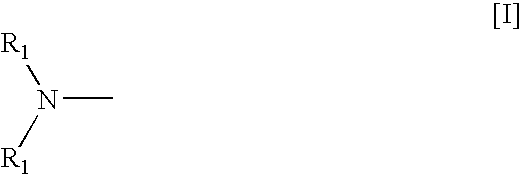Rubber composition containing modified conjugated diene polymer and tire
a conjugated diene polymer and rubber composition technology, which is applied in the direction of special tyres, transportation and packaging, tyre parts, etc., can solve the problems of high viscosity of rubber composition, inability to reduce the reinforcing property, and prolong the milling time, so as to achieve good wear resistance and good grip. , the effect of good heat buildup
- Summary
- Abstract
- Description
- Claims
- Application Information
AI Technical Summary
Benefits of technology
Problems solved by technology
Method used
Image
Examples
production example 1
(Production method of polymer A) no Modification H—H
[0089] Into a pressure glass vessel of about 900 ml in capacity dried and purged with nitrogen are charged 283 g of cyclohexane, 50 g of 1,3-butadiene monomer and a cyclohexane solution of 0.0057 mmol of 2,2-ditetrahydrofuryl propane, and 0.57 mmol of n-butyllithium (BuLi) is added, which is placed in a warm bath of 50° C. provided with a stirrer to conduct polymerization for 4.5 hours. The degree of conversion is approximately 100%. To this polymerization system is added 0.5 ml of a 5% solution of 2,6-di-t-butyl paracresol (BHT) in isopropanol to stop the reaction, and further the drying is carried out by the usual manner to obtain a polymer A. The vinyl bond content in butadiene portion is 14%, and the coupling efficiency is 0%.
example 2
Polymerization Example 2
(Production Method of Polymer B) Modification N—H
[0090] Into a pressure glass vessel of about 900 ml in capacity dried and purged with nitrogen are charged 283 g of cyclohexane, 50 g of 1,3-butadiene monomer and a cyclohexane solution of each of 0.0057 mmol of 2,2-ditetrahydrofuryl propane and 0.513 mmol of hexamethylene imine, and 0.57 mmol of n-butyllithium (BuLi) is added, which is placed in a warm bath of 50° C. provided with a stirrer to conduct polymerization for 4.5 hours. The degree of conversion is approximately 100%. To this polymerization system is added 0.5 ml of a 5% solution of 2,6-di-t-butyl paracresol (BHT) in isopropanol to stop the reaction, and further the drying is carried out by the usual manner to obtain a polymer B. The vinyl bond content in butadiene portion is 14%, and the coupling efficiency is 1%.
example 3
Polymerization Example 3
(Production Method of Polymer C) Modification H—Sn
[0091] Into a pressure glass vessel of about 900 ml in capacity dried and purged with nitrogen are charged 283 g of cyclohexane, 50 g of 1,3-butadiene monomer and a cyclohexane solution of 0.0057 mmol of 2,2-ditetrahydrofuryl propane, and 0.57 mmol of n-butyllithium (BuLi) is added, which is placed in a warm bath of 50° C. provided with a stirrer to conduct polymerization for 4.5 hours. The degree of conversion is approximately 100%. To this polymerization system is added a solution of 0.100 mmol of tin tetrachloride in cyclohexane, which is stirred at 50° C. for 30 minutes. Thereafter, 0.5 ml of a 5% solution of 2,6-di-t-butyl paracresol (BHT) in isopropanol is added to stop the reaction, and further the drying is carried out by the usual manner to obtain a polymer C. The vinyl bond content in butadiene portion is 14%, and the coupling efficiency is 69%.
PUM
| Property | Measurement | Unit |
|---|---|---|
| Fraction | aaaaa | aaaaa |
| Percent by mass | aaaaa | aaaaa |
| Percent by mass | aaaaa | aaaaa |
Abstract
Description
Claims
Application Information
 Login to View More
Login to View More - R&D
- Intellectual Property
- Life Sciences
- Materials
- Tech Scout
- Unparalleled Data Quality
- Higher Quality Content
- 60% Fewer Hallucinations
Browse by: Latest US Patents, China's latest patents, Technical Efficacy Thesaurus, Application Domain, Technology Topic, Popular Technical Reports.
© 2025 PatSnap. All rights reserved.Legal|Privacy policy|Modern Slavery Act Transparency Statement|Sitemap|About US| Contact US: help@patsnap.com



